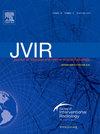对医疗差距和子宫动脉栓塞术的十年分析:探索健康的社会决定因素。
IF 2.6
3区 医学
Q2 PERIPHERAL VASCULAR DISEASE
Journal of Vascular and Interventional Radiology
Pub Date : 2024-11-23
DOI:10.1016/j.jvir.2024.11.016
引用次数: 0
摘要
目的:确定健康的社会决定因素对使用子宫动脉栓塞术(UAE)治疗无症状子宫肌瘤的影响程度:在这项获得 IRB 豁免的研究中,研究人员利用 2011-2020 年全国住院病人抽样调查的数据来确定哪些 ICD-9 和 -10 编码为子宫肌瘤的患者接受了 UAE 治疗。收集的数据包括:患者的人口统计学特征(种族/民族、收入、保险状况)和手术地点(地理区域、医院环境)。结果以百分比(每个变量的 UAE 程序)表示,并使用卡方检验进行分析:结果:按种族/民族分列的超短波辅助呼吸机使用情况呈以下分布:非西班牙裔黑人(45.6%)、非西班牙裔白人(28.1%)、西班牙裔(14.2%)和亚裔(5.7%)。收入最低的四分位数的使用率没有变化(27.8%),而收入最高的四分位数的使用率在十年间逐渐下降(2011:26.7%, 2020:19.0%, p=0.01)。美国东北部地区(2011 年为 49.0%)被南部地区(2020 年为 34.8%)取代,成为阿联酋的主要地区。主要的保险状况是私人保险(55.5%)和医疗补助(26.2%),医疗补助的比例在这十年中不断上升(2011 年:18.2%,2020 年:28.6%,P <0.001)。城市教学医院占阿联酋总比例最高(82.3%),相比之下,城市非教学医院(16.0%)和农村医院(1.2%)占比最低:结论:在过去的十年中,根据收入情况,做超导可视化手术的方式相对公平,医疗补助人群和美国各地区的使用率都有所提高。如果考虑到美国人口的代表性和疾病负担的不平等性,非西班牙裔黑人的超声心动图使用率高于预期,而非西班牙裔白人的使用率低于预期。本文章由计算机程序翻译,如有差异,请以英文原文为准。

A Decade Long Analysis of Healthcare Disparities and Uterine Artery Embolization: An Exploration of Social Determinants of Health
Purpose
To determine the extent of impact that social determinants of health have on uterine artery embolization (UAE) utilization for treatment of symptomatic uterine fibroids.
Materials and Methods
In this institutional review board (IRB)–exempt study, data from the 2011–2020 National Inpatient Sample were used to identify patients with International Classification of Diseases, 9th and 10th editions, codes of uterine fibroids who underwent UAE. Data collected included patient demographics (race/ethnicity, income, and insurance status) and procedure location (geographic region and hospital setting). Results are presented in percentage (UAE procedures per variable) and were analyzed using chi-square test.
Results
UAE utilization by race/ethnicity demonstrated the following distribution: 45.6% non-Hispanic Blacks, 28.1% non-Hispanic Whites, 14.2% Hispanics, and 5.7% Asians. The lowest quartile for income experienced no change in utilization (27.8%), while the highest quartile gradually decreased across the decade (2011, 26.7%; 2020, 19.0%; P = .01). The Northeast region of the United States (49.0% in 2011) was superseded by the South (34.8% in 2020) as the dominant geographic region for UAE. The main insurance statuses were private (55.5%) and Medicaid (26.2%), with Medicaid rates increasing throughout the decade (2011, 18.2%; 2020, 28.6%; P < .001). Urban teaching hospitals accounted for the highest rates of total UAE (82.3%) compared with urban nonteaching (16.0%) and rural hospitals (1.2%).
Conclusions
Over the past decade, UAE has been performed in a relatively equitable fashion on the basis of income level, with improved utilization within the Medicaid population and throughout the geographic regions of the United States. When accounting for U.S. population representation and unequal disease burden, non-Hispanic Blacks demonstrated a greater-than-expected utilization of UAE compared with lower-than-expected rates among non-Hispanic Whites.
求助全文
通过发布文献求助,成功后即可免费获取论文全文。
去求助
来源期刊
CiteScore
4.30
自引率
10.30%
发文量
942
审稿时长
90 days
期刊介绍:
JVIR, published continuously since 1990, is an international, monthly peer-reviewed interventional radiology journal. As the official journal of the Society of Interventional Radiology, JVIR is the peer-reviewed journal of choice for interventional radiologists, radiologists, cardiologists, vascular surgeons, neurosurgeons, and other clinicians who seek current and reliable information on every aspect of vascular and interventional radiology. Each issue of JVIR covers critical and cutting-edge medical minimally invasive, clinical, basic research, radiological, pathological, and socioeconomic issues of importance to the field.

 求助内容:
求助内容: 应助结果提醒方式:
应助结果提醒方式:


